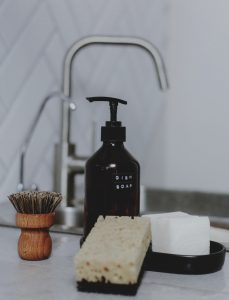
Sponges are the items in a kitchen that usually do the most work. From cleaning your dishes and kitchen utensils to your countertops and a number of other surfaces, they are always there for you. However, think about how much dirt and grime they go through on a daily basis. When you absorb the juice that you spilled on the floor, it all goes in that little colourful sponge. That is exactly why deep kitchen cleaning it is of such importance. You don’t want to drag around the dirt that has been trapped inside your sponge. A quick rinse will not do the trick since sponges are a perfect breeding ground for bacteria. It is proven that they are able to transfer microbes to stainless steel surfaces where those little guys can survive up to 4 days!
In order to ensure that E.coli and other nasty things which can be found around your kitchen, regular cleaning and disinfection of your tools is needed.
A cleaning sponge should be rinsed with hot water after every use and left in a well-ventilated spot where it can properly dry – ideally a sponge holder. It should also be sanitised and disinfected once every couple of days. All of this will keep your sponge germ free and healthy, however, you should replace it once in a while as well. Sponges do not last forever and it is best if you get a new one every 2-4 weeks (depending on how often you use it), or whenever you notice they have developed a smell or stains that cannot be removed.
Cleaning a kitchen sponge with bleach
If you choose this method, make sure you are in a well-ventilated area of the house and wear rubber gloves, especially if you have sensitive skin.
1. Mix a cleaning solution. Mix ¾ cup of chlorine bleach and 4 litres of hot water in a sink or a bucket.
2. Soak your sponges. Place your cleaning tools in the solution you just mixed and let them sit in it for 5 minutes. This method works well for cellulose and nylon scrubbing sponges.
3. Remove the sponges. Take your sponges out, squeeze out the excess moisture and let them air dry in a well-ventilated place.
Cleaning your sponges in the dishwasher
1. Load your dishwasher. Place your sponges on the top rack. You can use a small dishwasher basket if you are worried that the sponges may fall through the rack.
2. Select a suitable cycle. Add the dishwasher detergent and select a regular wash cycle with a heated drying cycle at the end.
3. Air dry the sponge. The sponges may come out of the dishwasher already dry. However, if they are not completely dry, you should place them in a well-ventilated area.
Cleaning your kitchen sponges with distilled white vinegar
Vinegar is a powerful solution that will help kill mould and mildew bacteria and rid you of other germs, grease, and grime.
1. Place your sponges in a bucket or a dishpan and pour enough vinegar to completely cover them.
2. Soak. Allow the sponges to sit in the vinegar for 5-10 minutes. When done with the soaking, wring them out and rinse them with hot water. Pour the leftover vinegar down your sink. That will help remove buildup.
3. Dry. Place the sponges on a drying rack or another well-ventilated area and let them air dry completely.
Cleaning your kitchen sponges in the microwave
Do not place any sponge that has metallic scrubbing fibres in the microwave. They will spark a fire inside.
1. Wet the sponge. Thoroughly wet your sponge (make sure it is dripping wet). That way you will prevent an accidental fire.
2. Microwave the sponge. Set the microwave on high power and microwave your sponge in a bowl. Wet cellulose sponges should be microwaved for 2 minutes and wet nylon scrubbing sponges for only 1 minute.
3. Let the sponge cool down. The sponges will come out extremely hot so let them cool down before you handle them.
4. Wring and dry. When done, wring out the excess moisture and let the sponge air dry.
Tips on how to keep your kitchen sponge fresh and clean for longer:
• Rinse the sponge in hot water after every use, especially when cleaning very dirty surfaces and objects.
• Keep your sponge in a dry, well-\ place, such as a sponge holder. By allowing your sponge to completely dry, you will prevent mould and bacteria growth.
• Do not use the kitchen sponge to soak up any juices produced by meat products. Use disposable paper towels instead.
• Disinfect your sponge using one of the methods above every other day.
• Get rid of your old sponge as soon as it starts smelling, becomes stained or starts crumbling and falling apart.
• Keep kitchen, floor, and bathroom sponges, as well as the different ones you use for various tasks separate. That way you will prevent cross-contamination.